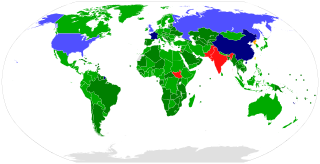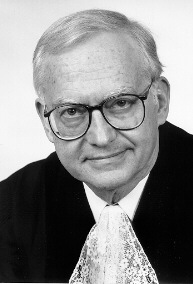
The International Court of Justice is the only international court that adjudicates general disputes between nations, and gives advisory opinions on international legal issues. It is one of the six organs of the United Nations (UN), and is located in The Hague, Netherlands.

The Treaty on the Non-Proliferation of Nuclear Weapons, commonly known as the Non-Proliferation Treaty or NPT, is an international treaty whose objective is to prevent the spread of nuclear weapons and weapons technology, to promote cooperation in the peaceful uses of nuclear energy, and to further the goal of achieving nuclear disarmament and general and complete disarmament. Between 1965 and 1968, the treaty was negotiated by the Eighteen Nation Committee on Disarmament, a United Nations-sponsored organization based in Geneva, Switzerland.
Trident Ploughshares is an activist anti-nuclear weapons group, founded in 1998 with the aim of "beating swords into ploughshares". This is specifically by attempting to disarm the UK Trident nuclear weapons system, in a non-violent manner. The original group consisted of six core activists, including Angie Zelter, founder of the non-violent Snowball Campaign.
Customary international law is an aspect of international law involving the principle of custom. Along with general principles of law and treaties, custom is considered by the International Court of Justice, jurists, the United Nations, and its member states to be among the primary sources of international law.
The International law bearing on issues of Arab–Israeli conflict, which became a major arena of regional and international tension since the birth of Israel in 1948, resulting in several disputes between a number of Arab countries and Israel.
International law, also known as "law of nations", refers to the body of rules which regulate the conduct of sovereign states in their relations with one another. Sources of international law include treaties, international customs, general widely recognized principles of law, the decisions of national and lower courts, and scholarly writings. They are the materials and processes out of which the rules and principles regulating the international community are developed. They have been influenced by a range of political and legal theories.

Rosalyn C. Higgins, Baroness Higgins, is a British former president of the International Court of Justice (ICJ). She was the first female judge elected to the ICJ, and was elected to a three-year term as its president in 2006.
Opinio juris sive necessitatis or simply opinio juris is the belief that an action was carried out as a legal obligation. This is in contrast to an action resulting from cognitive reaction or behaviors habitual to an individual. This term is frequently used in legal proceedings such as a defense for a case.
The use of force by states is controlled by both customary international law and by treaty law. The UN Charter reads in article 2(4):
All members shall refrain in their international relations from the threat or use of force against the territorial integrity or political independence of any state, or in any other manner inconsistent with the purposes of the United Nations.

The Nuclear Age Peace Foundation (NAPF) is a non-profit, non-partisan international education and advocacy organization. Founded in 1982, NAPF is composed of individuals and organizations from all over the world. It has consultative status to the United Nations Economic and Social Council and is recognized by the UN as a Peace Messenger Organization.

Stephen Myron Schwebel, is an American jurist and international judge, counsel and arbitrator. He previously served as judge of the World Bank Administrative Tribunal (2010–2017), as a member of the U.S. National Group at the Permanent Court of Arbitration, as president of the International Monetary Fund Administrative Tribunal (1993–2010), as president of the International Court of Justice (1997–2000), as vice president of the International Court of Justice (1994–1997), and as Judge of the International Court of Justice (1981–2000). Prior to his tenure on the ICJ, Schwebel served as deputy legal adviser to the U.S. Department of State (1974–1981) and as assistant legal adviser to the U.S. Department of State (1961–1967). He also served as a professor of law at Harvard Law School (1959–1961) and Johns Hopkins University (1967–1981). Schwebel is noted for his expansive opinions in momentous cases such as Legality of the Threat or Use of Nuclear Weapons, Military and Paramilitary Activities in and Against Nicaragua and Oil Platforms .

War can heavily damage the environment, and warring countries often place operational requirements ahead of environmental concerns for the duration of the war. Some international law is designed to limit this environmental harm.
Distinction is a principle under international humanitarian law governing the legal use of force in an armed conflict, whereby belligerents must distinguish between combatants and protected civilians. Combatant in this instance means persons entitled to directly participate in hostilities and thus are not afforded immunity from being directly targeted in situations of armed conflict. Protected civilian in this instance means civilians who are enemy nationals or neutral citizens outside of the territory of a belligerent power.

The Martens Clause is an early international law concept first introduced into the preamble of the 1899 Hague Convention II – Laws and Customs of War on Land. There are differing interpretations of its significance on modern international law, with some scholars simply treating the clause as a reminder international customary law still applies after a treaty is ratified while others take a more expansive approach where the clause provides that because international treaties cannot be all encompassing, states cannot use that as a justification for an action.
A nuclear weapons convention is a proposed multilateral treaty to eliminate nuclear weapons. This might include prohibitions on the possession, development, testing, production, stockpiling, transfer, use and threat of use of nuclear weapons, such as those in the Treaty on the Prohibition of Nuclear Weapons, along with provisions for their verified elimination. It could be similar to existing conventions outlawing other categories of weapons, such as biological weapons, chemical weapons, anti-personnel mines and cluster bombs.
The 13 steps are identified in a paragraph of the Final Document of the 2000 Review Conference of the Nuclear Non-Proliferation Treaty, providing a set of 'practical steps for the systematic and progressive efforts to implement Article VI of the Treaty on the Non-Proliferation of Nuclear Weapons'. Article VI is the part of the Treaty that provides for disarmament, including nuclear disarmament.

In United Nations Security Council resolution 984, adopted unanimously on 11 April 1995, the council gave assurances to non-nuclear weapon states that were parties to the Nuclear Non-Proliferation Treaty (NPT) against the threat of nuclear proliferation.
The Humanitarian Initiative is a group of states that evolved within the framework of the Nuclear Non-Proliferation Treaty (NPT) and nuclear weapons diplomacy more widely. 159 states subscribed to the last iteration of the initiative's Joint Statement in 2015. Since 2013, it led to a series of conferences exploring the Humanitarian Impact of Nuclear Weapons, culminating in the Humanitarian Pledge, issued by the Austrian Government, to "fill the legal gap for the prohibition and elimination of nuclear weapons". The Pledge has been endorsed by 108 governments as of 1 June 2015. The Humanitarian Initiative is seen as a direct answer to the lack of progress in nuclear disarmament.
Action AWE is a grassroots activist anti-nuclear weapons campaign/group launched in February 2013. Its aim is to increase and activate public opposition to the UK Trident nuclear weapons system, and depleted uranium warheads manufactured at AWE Burghfield, along with AWE Aldermaston.
The International Association of Lawyers against Nuclear Arms (IALANA) is an international non-governmental organisation headquartered in Berlin. It was founded in 1988 and seeks "to build and strengthen international legal efforts to ban the use and threat of use of nuclear weapons." Its membership consists of individual lawyers and lawyer's organisations. The current co-presidents of the organisation are Peter Becker and Takeya Sasaki. The German section of the organisation was co-founded by former German Minister of Justice Herta Däubler-Gmelin. IALANA had a central role in the process that sought an advisory ruling on the legality of nuclear arms from the International Court of Justice.










